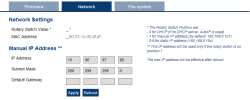Network Tab (PDMM or PCMM Only)
The contents of this tab display the current rotary switch position of the AKD PDMM or PCMM and its MAC address![]() A Media Access Control address (MAC address) is a quasi-unique identifier assigned to most network adapters or network interface cards (NICs) by the manufacturer for identification. If assigned by the manufacturer, a MAC address usually encodes the manufacturer's registered identification number. Additionally, you may manually change the AKD PDMM's or PCMM's IP address.
A Media Access Control address (MAC address) is a quasi-unique identifier assigned to most network adapters or network interface cards (NICs) by the manufacturer for identification. If assigned by the manufacturer, a MAC address usually encodes the manufacturer's registered identification number. Additionally, you may manually change the AKD PDMM's or PCMM's IP address.
Figure 7-4: Example of a AKD PDMM or PCMM with a manually defined IP address
About the Rotary Switch
The rotary switch on the AKD PDMM or PCMM can be set on a position from 0 to 9.
| Switch Position | Description |
|---|---|
| Position 0 | The drive tries to get an IP address from a DHCP server. If the DHCP fails, then the AKD PDMM or PCMM uses AutoIP to get a usable IP address. |
| Position 1 | The default custom static IP address, 192.168.0.101 or a custom IP address. |
| Position 2-9 | The AKD PDMM or PCMM is pre-configured with static IP addresses ranging from 192.168.0.102 (Position 2) to 192.168.0.109 (Position 9). |
-
-
If a DHCP server is not present, the drive will assume an Automatic Private IP Address of the form 169.254.x.x
Change the IP Address
To connect and use your AKD PDMM or PCMM within your computer network, you may configure its IP address by using the web server as follows:
- Open the controller's web server in your internet browser
- Select the Settings tabbed-page
- In the Network pane, set static IP address according to the position defined via the rotary switch
- If the rotary switch is set to Position 1 you may use the default custom address or set a value in the Manual IP Address fields.
- Configure the Manual IP Address
- Configure the subnet mask (default is 255.255.255.0)
- (Optional) Configure the gateway address if the AKD PDMM or PCMM is outside your local network
- Click Apply
- Click Reboot
-
- It is recommended to not use leading zeroes when entering an IP address. The webserver automatically configures numbers with leading zeroes as octal values. For example, use 10.1.1.10 instead of 010.001.001.010.







